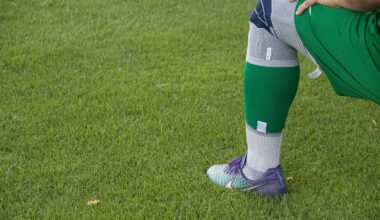Kettlebell Goblet Squat: A Full Guide for Women Fitness Enthusiasts
The kettlebell goblet squat is a fantastic exercise that targets multiple muscle groups, making it essential for fitness enthusiasts, particularly women who aim for strength and toning. This exercise engages not just the legs, but also the core and upper body. Holding a kettlebell close to your chest allows you to maintain an upright torso, essential for good form and posture during the squat. Aside from muscle benefits, this exercise aids in improving balance and flexibility, which are crucial for overall fitness. A goblet squat enables you to lift heavier weights while still promoting proper technique. It’s particularly effective for beginners who may struggle with traditional barbell squats. The kettlebell acts as a counterbalance, making the squat more manageable and accessible. Additionally, it’s a versatile movement that can be adapted for various fitness levels, from beginners to advanced athletes. Women, in particular, often find that this exercise boosts their strength and confidence in lifting. Overall, the kettlebell goblet squat is an excellent addition to any lower body workout routine.
To perform the kettlebell goblet squat correctly, begin by selecting an appropriate weight for your fitness level. Stand with your feet slightly wider than hip-width apart, toes angled slightly outward. Hold the kettlebell with both hands by the handles, resting it against your chest. Your elbows should point downward, staying close to your body for stability. Initiate the squat by bending at the hips and knees, lowering your body while keeping your chest lifted and your back straight. Go as low as you can while maintaining proper form, ideally until your thighs are parallel to the ground. Be sure to keep the kettlebell close to your chest throughout the movement to avoid any strain on your back. The emphasis should be on pushing through your heels as you rise out of the squat, extending fully at the hips and knees. Inhale as you lower down, and exhale powerfully as you come up. Practicing this movement regularly can lead to substantial gains in lower body strength, enhancing your overall fitness potential.
Benefits of Kettlebell Goblet Squat
The kettlebell goblet squat offers numerous benefits that make it a staple in any fitness program, especially for women. Firstly, it provides a full-body workout, engaging multiple muscle groups simultaneously, particularly the quadriceps, glutes, and core. This engagement improves overall muscular endurance and coordination, a key aspect of functional fitness. Furthermore, incorporating this exercise into your routine can lead to enhanced hypertrophy, which is essential for toning and shaping the body effectively. The kettlebell’s unique shape emphasizes grip strength and enhances core stability, contributing to better posture. Regularly performing goblet squats can also help increase muscular strength, allowing you to lift heavier over time. Moreover, for those looking to burn calories, goblet squats can be quite effective, particularly when combined with higher-intensity interval training (HIIT). They can elevate your heart rate, contributing to fat loss. Lastly, this exercise can significantly improve flexibility in the hips, which is crucial for mobility and injury prevention. Therefore, the kettlebell goblet squat is an exercise that truly has it all.
Incorporating the kettlebell goblet squat into your workout routine can be done in various ways. For those who are new to this exercise, starting with bodyweight squats can help familiarize yourself with the movement. Once confident, introduce the kettlebell to increase resistance. You can implement it into different workouts, including strength training sessions, cardiovascular routines, or even circuit training. It’s also beneficial to alternate between high-rep sets and low-rep, heavier sets to maximize strength gains. Consider adding goblet squats to your warm-up routine to activate your muscles and prepare your body for more intense training. Alternatively, they can serve as a great finisher to tire out your legs towards the end of a workout. Timing your repetitions and setting specific goals can aid in progress tracking. Online platforms often host tutorials and guided videos, which can enhance your understanding and technique. Joining a fitness community or hiring a personal trainer can provide better support and motivation. Overall, creativity in incorporating this exercise will keep your workout exciting and impactful.
Common Mistakes to Avoid
While the kettlebell goblet squat is an effective exercise, many common mistakes can hinder performance and potentially lead to injury. One of the most frequent errors is allowing the knees to cave inward during the squat. This can place unnecessary stress on the joints, and it’s essential to focus on keeping your knees aligned over your toes. Additionally, rounding the back can occur if you’re not attentive to your posture. Always aim for a neutral spine throughout the movement, avoiding any excessive arching or rounding. Another mistake is neglecting to engage the core, which is vital for stability. Your abdominal muscles should be tight to support your lower back. Furthermore, many individuals fail to squat deep enough, which minimizes the exercise’s overall benefits. Striving for a full range of motion is key; ideally, your thighs should be parallel to the ground. Lastly, the kettlebell should remain close to your body—allowing it to drift away can lead to poor form and injury risk. By avoiding these mistakes, you’ll maximize your workout effectively.
Proper nutrition plays a critical role in optimizing your kettlebell goblet squat performance and recovery. To fuel your workouts, consuming a balanced diet rich in protein, complex carbohydrates, and healthy fats is essential. Protein helps repair and build muscles, while carbs provide the necessary energy for intense training sessions. Aim for lean protein sources like chicken, turkey, fish, legumes, and dairy. Incorporate whole grains like brown rice or quinoa, which release energy slowly. Healthy fats found in avocados, nuts, and seeds support overall health and keep you satiated after workouts. Additionally, staying hydrated cannot be overemphasized; dehydration negatively impacts strength and endurance. Drink plenty of water before, during, and after your workouts to maintain optimum performance. Pre-workout snacks, such as a banana or oatmeal, can provide an energy boost without feeling too heavy. Furthermore, post-workout meals should emphasize recovery, combining protein and carbs to replenish glycogen stores and support muscle repair. Supplements like branched-chain amino acids (BCAAs) can also be beneficial in recovery, although whole foods should be prioritized. Tailor your nutrition according to workout intensity for the best outcomes.
Conclusion: Embrace the Kettlebell Goblet Squat
In conclusion, the kettlebell goblet squat is a remarkable exercise for women looking to improve their fitness levels and overall body strength. Its versatility makes it suitable for various fitness journeys, and its benefits extend from enhanced muscular strength to improved flexibility. By mastering proper technique and avoiding common mistakes, you’ll be able to harness its full potential. Remember, combining effective nutrition with your training will elevate your results further, helping you achieve your fitness goals efficiently. Whether you’re a beginner or an experienced fitness enthusiast, incorporating kettlebell goblet squats into your regimen presents endless opportunities for development and growth. Establishing a consistent workout routine that includes this dynamic exercise will keep your fitness journey exciting and rewarding. Don’t forget the importance of community and support throughout this process. Engaging with fellow fitness enthusiasts—whether online or in person—can motivate and inspire your efforts. In summary, by embracing the kettlebell goblet squat, you’re investing in not just your body but also in your overall health and well-being for years to come.


